Reference
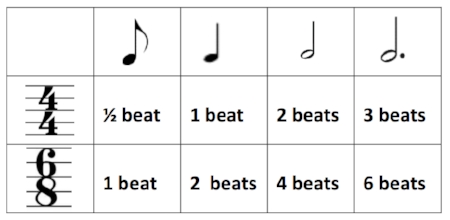
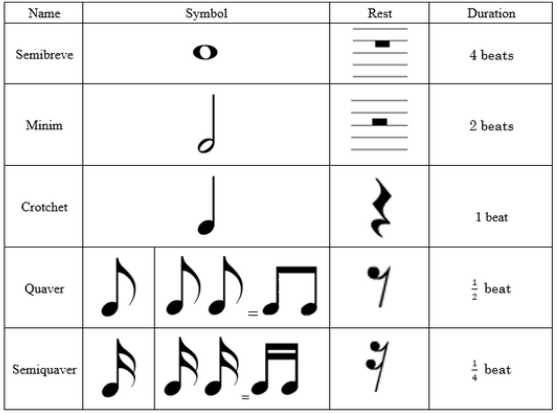

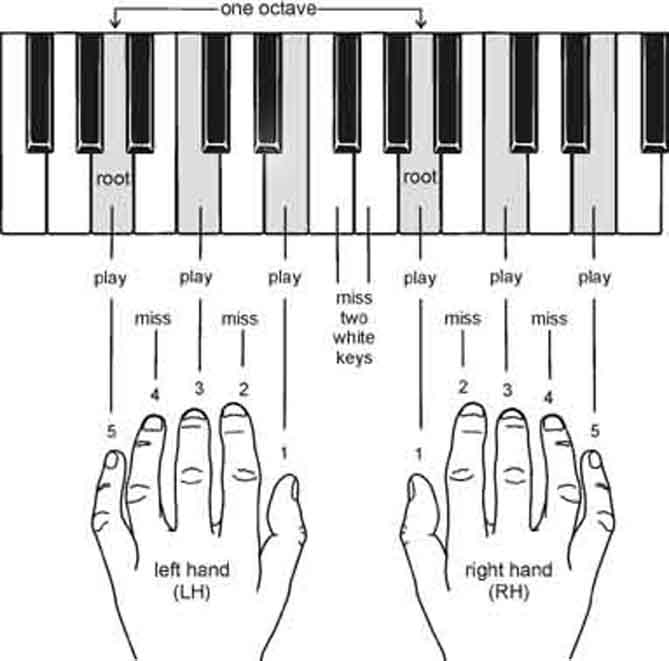




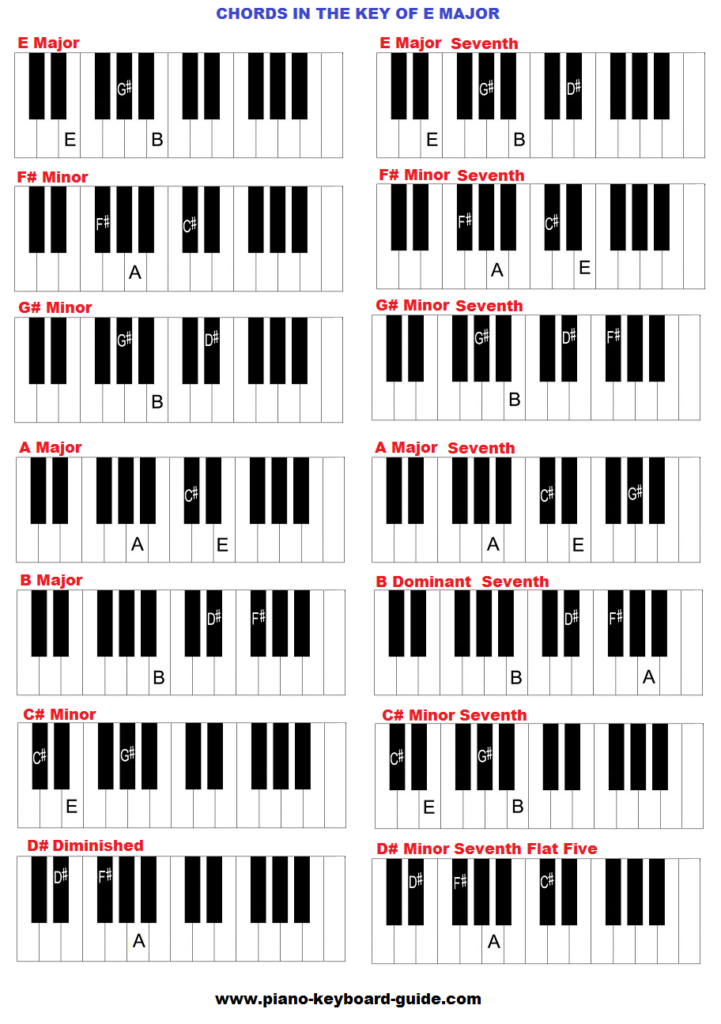
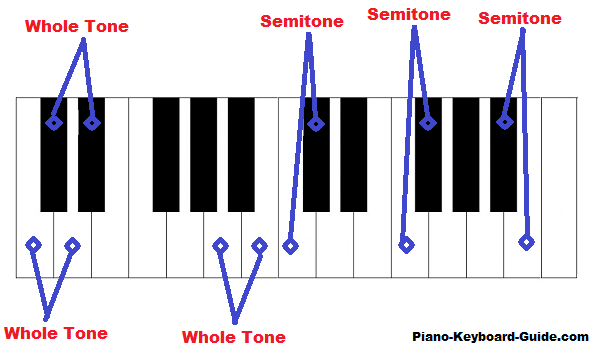


Dynamic Marks
The two basic dynamic indications in music are:
- or piano, meaning "soft"
- or forte, meaning "loud or strong"
More subtle degrees of loudness or softness are indicated by:
- standing for mezzo-piano, meaning "moderately soft"
- standing for mezzo-forte, meaning "moderately loud"
Use of up to three consecutive fs or ps is also common:
- standing for pianissimo and meaning "very soft"
- standing for fortissimo and meaning "very loud"
Piano
or piano, meaning "soft"
Forte
or forte, meaning "loud or strong"
Mezzo-piano
standing for mezzo-forte, meaning "moderately loud"
Mezzo-forte
standing for mezzo-piano, meaning "moderately soft"
Pianissimo
standing for pianissimo and meaning "very soft"
Fortissimo
standing for fortissimo and meaning "very loud"
Intervals
- Intervals are the spacing between notes.
Why do major and minor scales sound the way they do? It’s all in the intervals, and this chart shows you how.

Rhythm Identification
Whole
Half
Quarter
Eighth Notes and Rests
Dotted Rhythms
Dotted notes and their equivalent durations. The curved lines, called ties, add the note values together:

Dotted Whole
Half
Quarter Eighth Notes and Rests
Tempo Marks
The tempo of a piece of music is its speed.
The tempo of a piece of music is its speed. There are two ways to specify a tempo. Metronome markings are absolute and specific. Markings usually appear above the staff, at the beginning of the piece, and then at any spot where the tempo changes. Markings that ask the player to deviate slightly from the main tempo, such as ritardando may appear either above or below the staff.
Metronome Markings
Metronome markings are given in beats per minute. They can be estimated using a clock with a second hand, but the easiest way to find them is with a metronome, which is a tool that can give a beat-per-minute tempo as a clicking sound or a pulse of light. Figure shows some examples of metronome markings.

Tempo Terms
Traditionally, tempo instructions are given in Italian.
Some Common Tempo Markings:
- Grave - very slow and solemn (pronounced "GRAH-vay")
- Largo - slow and broad ("LAR-go")
- Larghetto - not quite as slow as largo ("lar-GET-oh")
- Adagio - slow ("uh-DAH-jee-oh")
- Lento - slow ("LEN-toe")
- Andante - literally "walking", a medium slow tempo ("on-DON-tay")
- Moderato - moderate, or medium ("MOD-er-AH-toe")
- Allegretto - Not as fast as allegro ("AL-luh-GRET-oh")
- Allegro - fast ("uh-LAY-grow")
- Vivo, or Vivace - lively and brisk ("VEE-voh")
- Presto - very fast ("PRESS-toe")
- Prestissimo - very, very fast ("press-TEE-see-moe")
These terms, along with a little more Italian, will help you decipher most tempo instructions.
More useful Italian:
- (un) poco - a little ("oon-POH-koe")
- molto - a lot ("MOLE-toe")
- piu - more ("pew")
- meno - less ("MAY-no")
- mosso - literally "moved"; motion or movement ("MOE-so")
Gradual Tempo Changes
If the tempo of a piece of music suddenly changes into a completely different tempo, there will be a new tempo given, usually marked in the same way (metronome tempo, Italian term, etc.) as the original tempo. Gradual changes in the basic tempo are also common in music, though, and these have their own set of terms. These terms often appear below the staff, although writing them above the staff is also allowed. These terms can also appear with modifiers like molto or un poco. You may notice that there are quite a few terms for slowing down. Again, the use of these terms will vary from one composer to the next; unless beginning and ending tempo markings are included, the performer must simply use good musical judgement to decide how much to slow down in a particular ritardando or rallentando.
Gradual Tempo Changes
- accelerando - (abbreviated accel.) accelerating; getting faster
- ritardando - (abbrev. rit.) slowing down
- ritenuto - (abbrev. riten.) slower
- rallentando - (abbrev. rall.) gradually slower
- rubato - don't be too strict with the rhythm; while keeping the basic tempo, allow the music to gently speed up and relax in ways that emphasize the phrasing
- poco a poco - little by little; gradually
- Tempo I - ("tempo one" or "tempo primo") back to the original tempo (this instruction usually appears above the staff)
Largo
Adagio
Andante
Moderato
Allegretto
Allegro
Vivace
Presto
Items on the Grand Staff
Articulation


Tied note
Slur
Legato
Staccato
Fermata
Accent
Notes on the Grand Staff

bar
measure
bar line
double bar line
Treble Clef
Bass Clef
bracket
time signature (and what each number means)
repeat sign
key signature

Another great tool for keeping track of your key signatures, the circle of fifths is an excellent guide to have nearby.

ledger line
Middle C
Concepts
Make sure you understand the following concepts:
-
Dynamic Marks
- pianissimo
- piano
- mezzo-piano
- mezzo-forte
- forte
- fortissimo
-
Intervals
- Unison
- 2nd(s)
- 3rds
- 4ths
- 5ths
- 6ths
- 7ths
- octaves
-
Rhythm Identification
- Whole
- Half
- Quarter
- Eighth Notes and Rests
-
Dotted Rhythms
- Dotted Whole
- Half
- Quarter Eighth Notes and Rests
-
Tempo Marks
- Largo
- Adagio
- Andante
- Moderato
- Allegretto
- Allegro
- Vivace
- Presto
-
Items on the Grand Staff
- bar
- measure
- bar line
- double bar line
- Treble Clef
- Bass Clef
- bracket
- time signature (and what each number means)
- repeat sign
- key signature
- ledger line
- Middle C
-
Articulation
- tied note
- slur
- legato
- staccato
- fermata
- accent
-
Notes on the Grand Staff**: Part of the test will be note identification


















